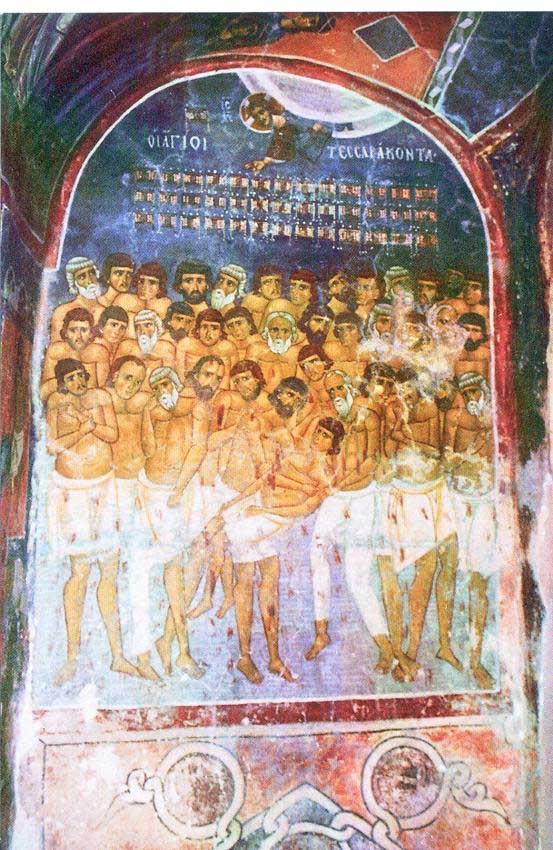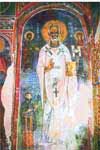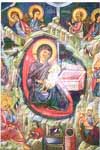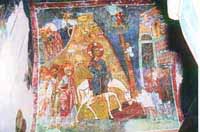.

The death of the forty martyrs, Agios Nikolaos tis Stegis Church, 12th century wallpainting
near Kakopetria
The Forty Martyrs of Sebaste or the Holy Forty (Ancient/Katharevousa Greek Ἃγιοι Τεσσεράκοντα, Demotic Άγιοι Σαράντα) were a group of Roman soldiers in the Legio XII Fulminata who became martyrs for their Christian faith in 320.
They were killed near Sebaste, in Lesser Armenia, victims of the persecutions of Licinius, who, after the year 316, persecuted the Christians of the East. The earliest account of their martyrdom is given by St. Basil, Bishop of Caesarea (370–379), in a homily delivered on the feast of the Forty Martyrs (Hom. xix in P.G., XXXI, 507 sqq.). The feast is consequently more ancient than the episcopate of Basil, whose eulogy on them was pronounced only fifty or sixty years after martyrdom.
According to St. Basil, forty soldiers who had openly confessed themselves Christians were condemned by the prefect to be exposed naked upon a frozen pond near Sebaste on a bitterly cold night, that they might freeze to death. Among the confessors, one yielded and, leaving his companions, sought the warm baths near the lake which had been prepared for any who might prove inconstant. One of the guards set to keep watch over the martyrs beheld at this moment a supernatural brilliancy overshadowing them and at once proclaimed himself a Christian, threw off his garments, and placed himself beside the thirty-nine soldiers of Christ. Thus the number of forty remained complete. At daybreak, the stiffened bodies of the confessors, which still showed signs of life, were burned and the ashes cast into a river. The Christians, however, collected the precious remains, and the relics were distributed throughout many cities; in this way the veneration paid to the Forty Martyrs became widespread, and numerous churches were erected in their honour.
The names of the Forty Martyrs
The Menaion of the Eastern Orthodox Church lists the names of the Forty Martyrs as follows:
* Hesychius, Meliton, Heraclius, Smaragdus, Domnus, Eunoicus, Valens, Vivianus, Claudius, Priscus, Theodulus, Euthychius, John, Xantheas, Helianus, Sisinius, Cyrion, Angius, Aetius, Flavius, Acacius, Ecditius, Lysimachus, Alexander, Elias, Candidus, Theophilus, Dometian, Gaius, Gorgonius, Leontius, Athanasius, Cyril, Sacerdon, Nicholas, Valaerius, Philoctimon, Severian, Chudion, and Aglaius.
According to Antonio Borrelli, their names were:
* Aetius, Eutychius, Cyrius, Theophilus, Sisinnius, Smaragdus, Candidus, Aggia, Gaius, Cudio, Heraclius, John, Philotemon, Gorgonius, Cirillus, Severianus, Theodulus, Nicallus, Flavius, Xantius, Valerius, Aesychius, Eunoicus, Domitian, Domninus, Helianus, Leontius (Theoctistus), Valens, Acacius, Alexander, Vicratius (Vibianus), Priscus, Sacerdos, Ecdicius, Athanasius, Lisimachus, Claudius, Ile, Melito and Eutychus (Aglaius).
 |
 |
 |
 |
 |
Images Cyprus, Nicosia District
See also Icons, Byzantine Art
| Ancient Greece
Science, Technology , Medicine , Warfare, , Biographies , Life , Cities/Places/Maps , Arts , Literature , Philosophy ,Olympics, Mythology , History , Images Medieval Greece / Byzantine Empire Science, Technology, Arts, , Warfare , Literature, Biographies, Icons, History Modern Greece Cities, Islands, Regions, Fauna/Flora ,Biographies , History , Warfare, Science/Technology, Literature, Music , Arts , Film/Actors , Sport , Fashion --- |

